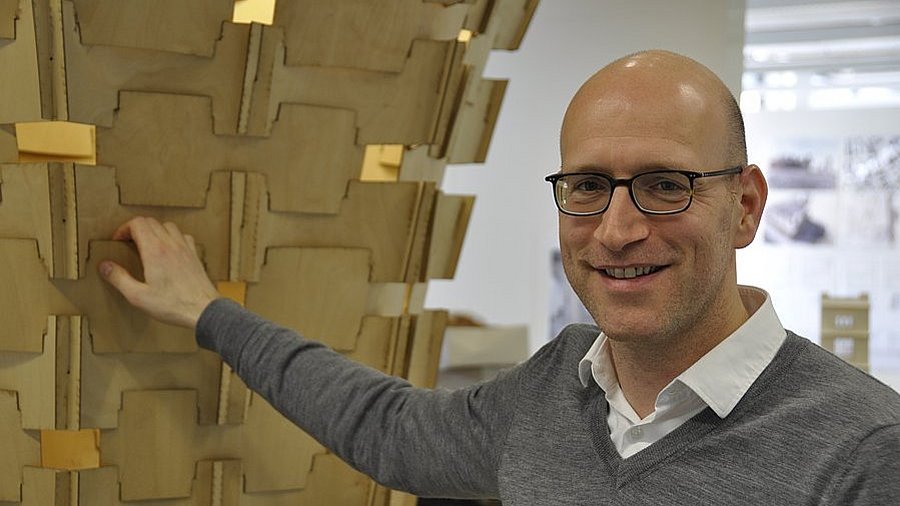
The pink elephant in the flower bed
Prof. Dip.-Ing. Holger Hoffmann / Architecture
Photo: UniService Transfer
The pink elephant in the flower bed
Architecture professor Holger Hoffmann on a campaign by the Association of German Architects (BDA) to repurpose Platz am Kolk
Mayor Uwe Schneidewind once called the square at Kolk, which Wuppertal citizens have experienced for many years as a car park, market replacement or temporary green space, "an important square of great urban planning significance". Holger Hoffmann, architect and professor at the University of Wuppertal, says: "Squares are the living rooms of a city. And the interlinking of squares and streets is of great importance for the spatial sequencing of the city - and thus for its quality of life." The square at Kolk is so immensely important because it enables the transition from Elberfeld's city centre to the east, with a direct connection to the Hofaue creative quarter and the future Pina Bausch Centre. The better this square functions, the more successful the connection will be.
The Bund Deutscher Architektinnen und Architekten Wuppertal (BDA) under its chairmen Holger Erke and Volker Hofmann therefore invited all citizens last Saturday to contribute their ideas to the possible reutilisation of this location.
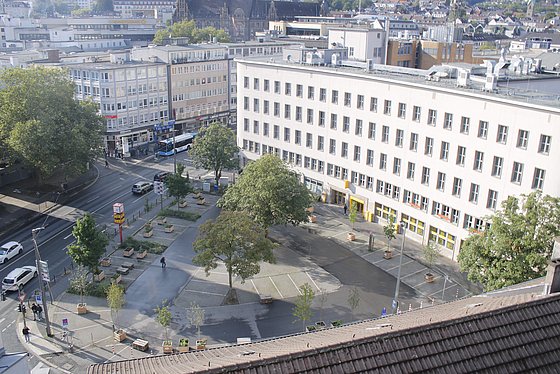
Square at the Kolk
Photo: Architecture BU
Planning after the war has long been problematic
Urban spaces have always grown with a city, and from today's perspective this is also problematic. Hoffmann comments: "If you look at the spatial qualities that are ultimately central to the atmosphere, flair and attractiveness of a city, the planning of the car-friendly city after the war was a disaster. This planning also inflicted a number of wounds on Wuppertal that are almost impossible to heal. Fortunately, however, the square at the Kolk is of high quality, both in terms of scale and proportion and in important architectural terms - just think of the post office building and the church. And there are neighbours who could also use this square. A transformation of the square at the Kolk would therefore be comparatively 'low hanging fruit'."(Low hanging fruits are tasks where maximum success can be achieved with minimum effort. Editor's note)
Alternatives to the car
The whole world relies on the car as a tried and tested means of transport, even in the city. In Hoffmann's opinion, however, this does not have to be the primary mode of transport if the city is to be understood as a place of community. "With the construction of the suspension railway over 100 years ago, Wuppertal showed how forward-looking mobility works. Travelling through the city and experiencing the spaces and people is incredibly fascinating. This ambition seems to have been forgotten." Cities such as Amsterdam, Copenhagen and Münster have long since proven that it is much easier to get around the city without a car. The weather is no excuse, as it rains no less in these cities than in Wuppertal, and the topography is no longer a valid counter-argument, at least since the introduction of e-bikes. "The Bund Deutscher Architektinnen und Architekten Wuppertal (BDA) (Association of German Architects in Wuppertal) has already used the square at the Kolk as a square without cars two years ago. We are taking up the issue again, as the square is too often left unused. It is important that we do not forget the great potential of the city. And because the city doesn't just interest us architects, but of course everyone else too, we thought about how we could bring together all the intentions, hopes and wishes using this specific location as an example. Today, there are easily accessible and playful tools for this."
Architecture students turn citizens' ideas into AI
On the day of action, the ideas of interested parties were implemented by students using AI. "Our students have long been using generative AI in all kinds of areas," explains Hoffmann. "Whether for researching and supporting the writing of texts or algorithms, or for basic architectural tasks such as creating models and drawings or - as in this case - visualising projects." This is done via so-called "prompts" (a prompt is an instruction signal or input directed to an AI system to initiate a specific response or action, editor's note), a low-threshold but impressive application. Everyone knows about 'alternative realities' that can be generated very realistically, explains the expert and says: "For us architects, who are always thinking about possible futures, generative AI is therefore a powerful tool. And even non-architects can create imaginative images using text input. Together with the visitors, we simply wrote down how they imagined a future space at the Kolk. There are no limits to the creation of images and such an approach is quite playful. The visions created were projected onto a large screen in the city." Visitors were also able to take home printed images with their own visions of the square.
The campaign was prepared by colleagues from the BDA, who used their contacts, invested a lot of time themselves and also organised the necessary budget. The students Anton von der Heyden and Leonard Idelberger were responsible for the technical realisation on site and were technically adept and committed in their use of hardware, AI and visitors alike.
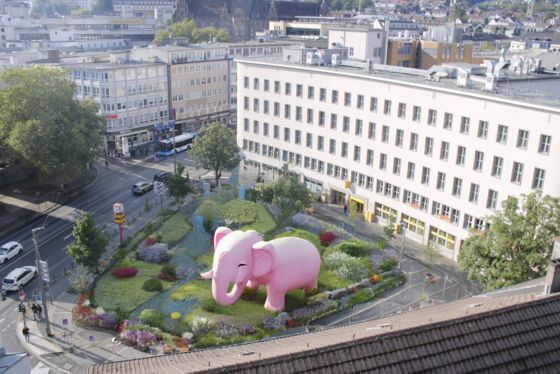
The pink elephant in the flower bed
a vision: Simulation - Architecture BU
The pink elephant in the flower bed
Anyone who had an idea for redesigning the square at the Kolk could contact the two students, who then called up an image of the "naked" square on the computer and marked the entire area, or just certain points on it, in order to fill it with the wishes and ideas of interested visitors. "We used the Adobe Library, a web service with countless images that are then integrated into the marked area," says Anton von der Heyden, explaining the process. This is how the pink elephant in the field of flowers was created, a version that would certainly be an eye-catcher. The makers projected the results onto a large screen in the centre of the square at the Kolk for all to see.
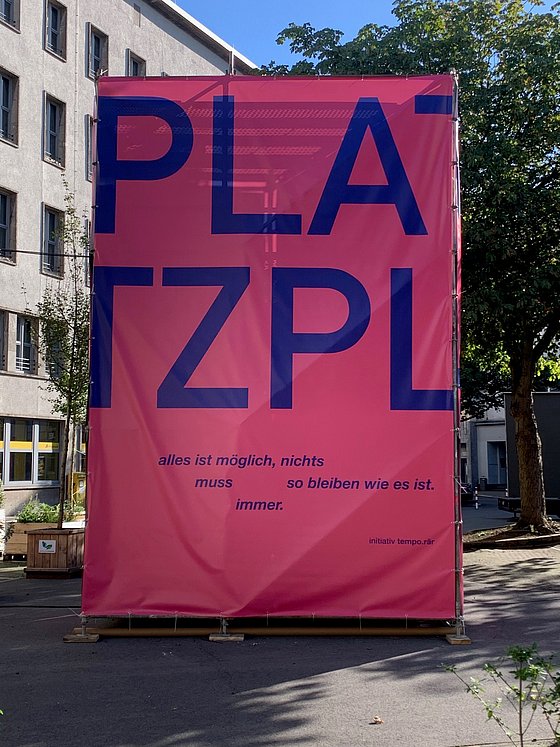
Poster for the campaign
Photo: UniService Transfer
Nothing has to stay as it is
Platz am Kolk is just one part of an initiative between Elberfeld and Barmen. The results of the dialogue of the joint initiative of the BDA and the City of Wuppertal "Quality Open City Centre", which has been running since 2016, were also on display for information on the project day at Platz am Kolk. "It was important for us to show that the city is a living organism and that it thrives on us constantly thinking ahead. This is also shown by our large poster with the inscription: Everything is possible, nothing has to stay as it is," explains Hoffmann.
As those involved know that changes are always long processes, campaigns like this one at the Kolk are important to drive these changes forward. "We can also see from the plans for the BUGA that Wuppertal is always able to realise projects that point to the future. And we want to support this."
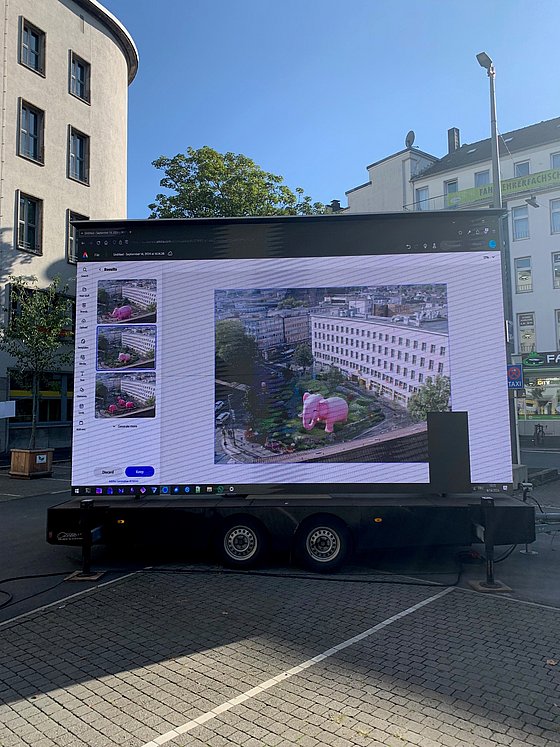
Every visitor was able to see the results immediately on a large screen
Photo: UniService Transfer
What could the square at the Kolk look like in the future?
"I believe that we need places for people in the city that are used and lived by people," says Hoffmann. Quite a few of the visitors therefore visualised the Platz am Kolk as a park or a heavily planted square. A market hall with a Mediterranean flair and a skate park also clearly showed that there is a need for communal space. To counteract the car park atmosphere in the short term, unsealing, benches and green spaces may be needed. "On the other hand, we have the great advantage that we have direct access to the city centre, so people are always walking here. In the long term, a kind of pavilion could screen off the square and provide a venue.
Hoffmann concludes by explaining that if programmes could be held in this location that could also be organised by local residents, meaning that the square could be used again and again, then it would also become clearer to citizens that more could be done with such a square than just using it for parking, as there are plenty of multi-storey car parks in the surrounding area.
Uwe Blass
Prof Holger Hoffmann is Professor of Representation Methodology and Design at the University of Wuppertal and founder of the Düsseldorf-based architecture firm one fine day. After graduating from the Münster School of Architecture, he worked as an architect at Bolles+Wilson in Münster and, after graduating from the Städelschule in Frankfurt, at UNStudio, Amsterdam. Since then, his interests in practice, teaching and research (among others) have focussed on the computer-aided design, representation and production of architecture, with a particular interest in typological and tectonic issues
